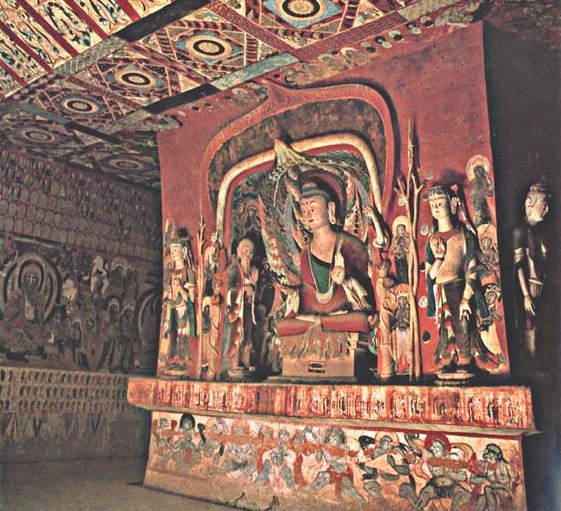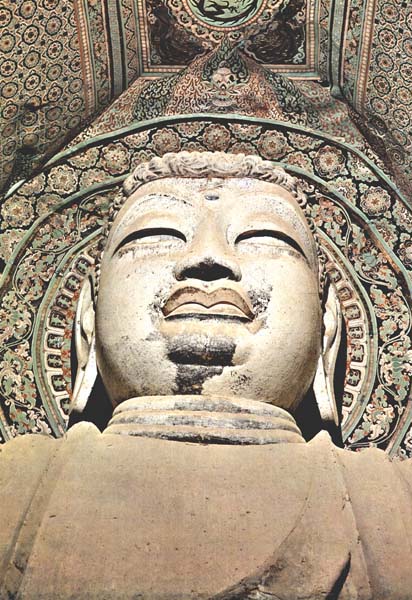
The idea of constructing Buddhist temples by hollowing out rock faces was brought to China from Central Asia, where monuments of this sort had been constructed for centuries. Over the years, more and more caves would be excavated and decorated as pious acts on the part of monks and artists. Most of the cave temples were begun in the north during the Northern Dynasties. Cave temples at Dunhuang were begun in 366; at Bingling and Maijishan in the early fifth century; at Yungang in 460; at Longmen and Gongxian in the early sixth century. During the Tang period additions were made to many of these cave temple complexes, especially Dunhuang and Longmen. | |||
DUNHUANG
Positioned in the furthest reaches of northwestern China, Dunhuang served as a gateway into China from Central Asia. Beginning in the fifth century, and continuing through the tenth, approximately five hundred rooms were carved into the area's soft rock. These rooms were decorated with sculptures and frescoes in styles which changed over the centuries. What you see here is only a tiny fraction of the art that can still be seen in the 492 surviving caves at Dunhuang. Below is a painted room in Dunhuang, which was first completed in the Western Wei period (6th century).
| |||
| |||
| |||
Below is a painted stone relief altar. | |||
How many of the figures can you identify? How does the Buddha image in this group compare with Buddha images you have already seen in this unit? | |||
| |||
| |||
To the left is a huge Buddha from the mid-Tang (712-781). Do you think images like this one had an impact on the financial relationship between the clergy and laity in Tang China? If so, why? Do you remember seeing patterns like the ones in this background anywhere else in the unit? What do you think the patterns are meant to represent? | |||
| |||
To review images from Dunhuang shown in previous sections of this unit click here. | |||
YUNGANG
In 386 the Northern Wei dynasty was declared by the Tuoba, a nomadic people from the north. As it consolidated power in north China during the fifth century, this non-Han dynasty found it beneficial to associate themselves with the burgeoning popularity of Buddhism. Despite this, the Northern Wei emperor Taiwu (r. 424-452) was persuaded by Daoist and Confucian officials at court to curb the Buddhist church. This persecution of Buddhism, begun in 446, lasted until his death in 452. Taiwu's grandson, Wencheng (r. 452-465) succeeded him and reinstated Buddhism to its previous, eminent position. One of the ways in which he made up for his grandfather's actions was by commissioning the excavation of some of the enormous caves at Yungang.
Today, over 50,000 statues from the 52 caves survive. Below is an outdoor shot of Yungang. Most of the caves here (Caves 21-45) date back to the 5th century.
The front walls of many of the caves have eroded away, so that some of the larger statues can now be viewed from a distance, as seen below. | |||
| |||
| |||
Below is an immense gilded Buddha from Yungang from the fifth century. It is approximately the height of a four-story house. | |||
How do you think monuments like this one fit within the history of Buddhism during the Northern Wei?
| |||
| |||
| |||
To the left is a close-up of figures carved into the cave wall at Yungang during the Northern Wei period (5th century). The bright colors are a modern attempt to restore the original painting. Why do you think each Buddha figure is situated in its own niche? | |||
| |||
Here is another recently re-painted stone relief from Yungang, also fifth century. Look at the composition of the art displayed on these walls. Why do you think these images were arranged the way they are? | |||
| |||
To review images from Yungang shown in previous sections of this unit click here. | |||
LONGMEN
Although construction of the cave temples at Longmen were begun in the early sixth century, the bulk of the sculptures there date from the Tang period. One of the more illustrious patrons of the caves was Empress Wu, the controversial Tang ruler who commissioned approximately 380 images for the Longmen caves between the years 655 and 705.
Over 100,000 images can be found in the approximately 1,300 caves of Longmen. These images range in size from 2 cm (0.8 in) to 17 m (56 ft).
Here is a close-up of one of the central figure from Fengxian Monastery at Longmen, completed during the first half of the eighth century. | |||
Can you tell which deity this is by just looking at the face? | |||
|
| |||
Below we see a full view of the massive stone statue of which you just saw a detail.
With a full view can you now identify which figure was just shown to you? Can you identify the figure second to the right of him? | |||
| |||
| |||
| |||
A common theme at Longmen and other cave temples is the "thousand Buddhas," usually portrayed by small, repeated images. What do you think is the effect of a repetitive image like this one? Why do you think someone would repeat an image of a sacred figure?. | |||
|
| ||
To review a sculpture from Longmen shown in one of the previous sections of this unit click here . | |||
Move on to Urban Temples
| |||

 What visual effect is achieved by a room completely decorated with painted images? Does the style of the painted images evoke any particular emotional response from the viewer?
What visual effect is achieved by a room completely decorated with painted images? Does the style of the painted images evoke any particular emotional response from the viewer?








Word Virus: Buddhist Cave Temples >>>>> Download Now
ReplyDelete>>>>> Download Full
Word Virus: Buddhist Cave Temples >>>>> Download LINK
>>>>> Download Now
Word Virus: Buddhist Cave Temples >>>>> Download Full
>>>>> Download LINK